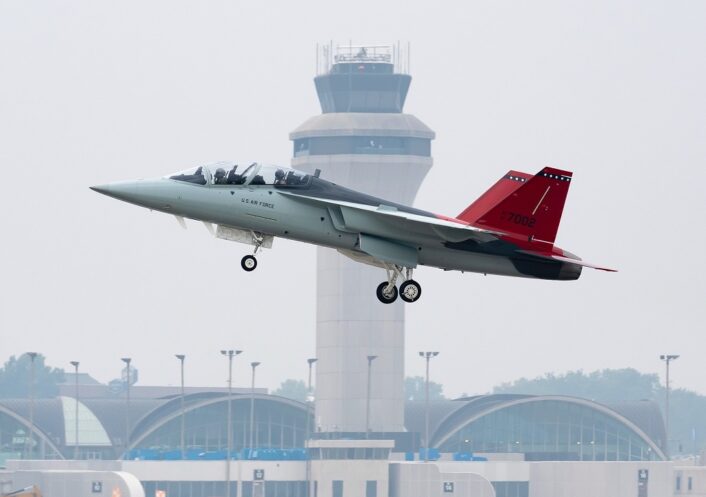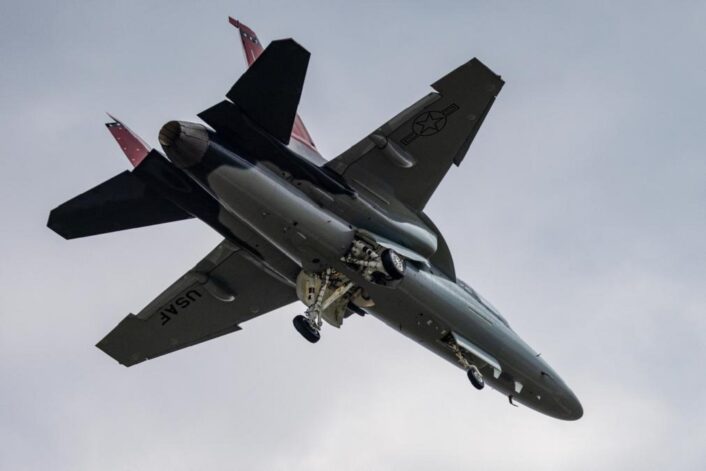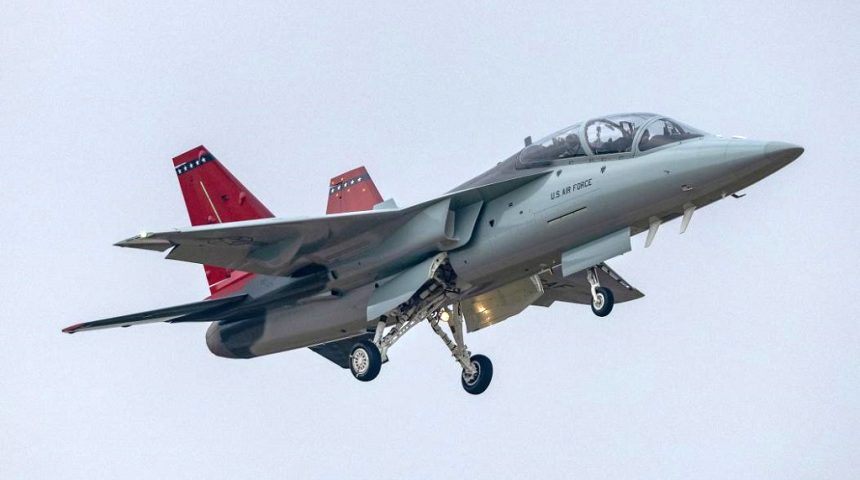This first USAF flight, which validated key aspects of the next-generation trainer, marks the start of the engineering and manufacturing development phase.
A U.S. Air Force test pilot finally flew at the commands of a Boeing T-7A Red Hawk, in what was officially the inaugural flight of the service’s first next generation trainer. While the one on June 28, 2023, was the first flight with a military pilot on board, thanks to ADS-B tracking we know that the first USAF T-7 already flew for the first time last week, on June 22.
“This first flight with the Air Force represents our team’s commitment to delivering a new level of safety and training for fighter and bomber pilots,” said Evelyn Moore, vice president and program manager, Boeing T-7 Programs. “We remain focused on engineering ways to better prepare warfighters for changing mission demands and emerging threats.”
Tails of red fly overhead❗️
The first T-7A #RedHawk soared through the sky completing its first flight with the @USAirForce. A U.S. Air Force pilot tested the red-tailed jet and demonstrated the power and agility of the advanced trainer. pic.twitter.com/PTcse79HWJ
— Boeing Defense (@BoeingDefense) June 28, 2023
During the 1 hour and 3 minute flight, U.S. Air Force Maj. Bryce “Triple” Turner, 416th Test Squadron, and Steve Schmidt, Boeing T-7 chief test pilot, validated key aspects of the aircraft, marking the start of the engineering and manufacturing development (EMD) phase of the program. The aircraft, serial 21-7002, is one of five EMD aircraft that will be delivered to the Air Force Air Education and Training Command for further testing.
HISTORY MADE!
At 11:51 CST, Maj. Bryce Turner made the first #USAF flight in the @BoeingDefense T-7A Red Hawk. The T-7A is an advanced pilot training system for the warfighter.
Congratulations to the team! #AFMC pic.twitter.com/dTxFcfpbEz
— Edwards Air Force Base (@EdwardsAFB) June 28, 2023
The choice of Maj. Turner as the first military pilot to fly on the Red Hawk was not casual. As mentioned in the presentation video released before the flight, Turner is a third-generation Air Force pilot and also an African American just like the Tuskegee Airmen, the first African American U.S. military aviators who flew red-tailed fighters during World War II, whose legacy is referenced by the name Red Hawk assigned to the T-7.
“It’s not any other test for me when I jump in this aircraft. With the heritage and the name, I want to make sure that we stay true to that legacy and we keep the name proud. No other fighter pilots in the world had to go through what they had to go through, they’re true role models for me,” said Maj. Turner. “First time I’ll get to fly this jet with the red tail, with the heritage, I’ll definitely take a second to reflect, to know everything that had to happen before this to get me to this point. I think that’s going to be a very special moment, I’m looking forward to it.”

What’s next
After the acceptance flights, the first T-7 is expected to move to Edwards Air Force Base to continue the test campaign. “This is an exciting time for the entire team,” said Col. Kirt Cassell, U.S. Air Force T-7A Red Hawk program manager. “The Red Hawk’s digital design integrating advanced training capabilities will drastically improve pilot training for the next generation of fighter and bomber pilots.”
Boeing says the T-7A will enhance warfighter training through:
- Improved pilot readiness: The all-new advanced pilot training system uses high resolution ground-based training systems and simulators to deliver robust and realistic integrated live, virtual and constructive training capabilities.
- Safety: Model-based engineering enabled testing throughout the aircraft’s design and build to help ensure safety before the first flight. The T-7A’s cockpit egress system is the safest of any trainer.
- Flexibility for any mission: With open architecture software and digital fly-by-wire controls, the T-7A supports training for a wide variety of fighter and bomber pilots and can evolve as technologies, threats and training needs change.
“Red-y” to fly❗️
Meet the first @USAirForce pilot to fly the #T7A Red Hawk, Maj. Bryce Turner, and learn why his first flight of the aircraft honoring the Tuskegee Airmen will be a “very special moment” for him. pic.twitter.com/V7Uf4HkmBi
— Boeing Defense (@BoeingDefense) June 27, 2023
However, it will take a long time to see these capabilities in action. In fact, according to U.S. Air Force’s Service Acquisition Executive Andrew Hunter, the new advanced trainer jet won’t achieve the Initial Operational Capability until early 2027, a year later than the latest projection after the milestone was first moved from the original 2024 target.
The delay is caused by the postponement of the Milestone C decision, as the beginning of the low-rate initial production had to be delayed because of issues discovered in early flight testing, now solved, and others discovered during testing of the ejection seat. Because of the latter, flight testing by Air Force pilots had to be delayed too, as the jet qualified for the Military Flight Release only two weeks ago.

The T-7’s design philosophy aligns with the US Air Force’s Digital Century Series strategy, which sees the use of advanced manufacturing, agile software development and digital engineering technology to significantly reduce the time from design to first flight. Because of this, the T-7A was able to move from firm concept to flight testing in 36 months, with the first flight in 2016. Even if this philosophy allowed to identify and mitigate issues earlier in the development, other issues such as supplier-side critical parts shortages, initial design delays and the need for additional testing to solve stability issues delayed the program.
With the developmental flight testing of the T-7A Red Hawk beginning this summer and the Milestone C now planned for early 2025, the first non-EMD aircraft would be delivered between the end of 2025 and the beginning of 2026. In the meanwhile, however, the Air Force might have to further extend the service life of some of the T-38s, which are already more than 60 years old.
Thanks again to Jerry McGrath for the photos he sent us and make sure to follow him on Instagram for more!









